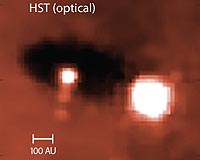 |
Paris, France (ESA) Jul 06, 2009 Last night, the detectors of Planck's High Frequency Instrument reached their amazingly low operational temperature of -273.05 degrees C, making them the coldest known objects in space. The spacecraft has also just entered its final orbit around the second Lagrange point of the Sun-Earth system, L2. Planck is equipped with a passive cooling system that brings its temperature down to about -230 degrees C by radiating heat into space. Three active coolers take over from there, and bring the temperature down further to an amazing low of -273.05 degrees C, only 0.1 degrees C above absolute zero - the coldest temperature theoretically possible in our Universe. Such low temperatures are necessary for Planck's detectors to study the Cosmic Microwave Background (CMB), the first light released by the universe only 380 000 yrs after the Big Bang, by measuring its temperature across the sky.
Like measuring the heat of a rabbit on the Moon
Arriving at L2 Once commanded, the burn was auto-controlled by Planck, with the thrusters operating for between 12 and 24 hours. The manoeuvre directed the satellite into its final operational orbit around the second Lagrange point of the Sun-Earth system, L2. The thruster burn was planned to deliberately underperform by a small margin, necessitating a small 'touch up' manoeuvre in the coming days to bring the satellite fully onto its planned trajectory. "While this manoeuvre itself is routine, it represents the final major step in the long voyage to L2, and everyone here is quite happy to see Planck getting into its operational orbit," said Chris Watson, Spacecraft Operations Manager, speaking in the mission's Dedicated Control Room at ESA's European Space Operations Centre, Darmstadt, Germany. The manoeuvre was planned to change the satellite's speed by 211.6 km/hour, ending with a final speed of 1010 Km/hour with respect to the ground. Together with Earth and the virtual point L2, Planck will then be orbiting the Sun at a speed of 106 254 km/hour (29.5 km/second). At the start of yesterday's manoeuvre, Planck was located 1.43 million km from Earth.
Science operations to begin soon Planck will begin to survey the sky in mid-August. Share This Article With Planet Earth
Related Links Planck Stellar Chemistry, The Universe And All Within It
 A Pair Of Solar Systems In The Making
A Pair Of Solar Systems In The MakingManoa HI (SPX) Jul 06, 2009 Two University of Hawaii at Manoa astronomers have found a binary star-disk system in which each star is surrounded by the kind of dust disk that is frequently the precursor of a planetary system. Doctoral student Rita Mann and Dr. Jonathan Williams used the Submillimeter Array on Mauna Kea, Hawaii to make the observations. A binary star system consists of two stars bound together by ... read more |
|
| The content herein, unless otherwise known to be public domain, are Copyright 1995-2009 - SpaceDaily. AFP and UPI Wire Stories are copyright Agence France-Presse and United Press International. ESA Portal Reports are copyright European Space Agency. All NASA sourced material is public domain. Additional copyrights may apply in whole or part to other bona fide parties. Advertising does not imply endorsement,agreement or approval of any opinions, statements or information provided by SpaceDaily on any Web page published or hosted by SpaceDaily. Privacy Statement |